These NCERT Solutions for Class 6 Science Chapter 14 Water Questions and Answers are prepared by our highly skilled subject experts to help students while preparing for their exams.
Water NCERT Solutions for Class 6 Science Chapter 14
Class 6 Science Chapter 14 Water Textbook Exercise Questions and Answers
Question 1.
Fill up the blanks in the following:
a. The process of changing of water into its vapour is called ……………..
b. The process of changing water vapour into water is called ……………..
c. No rainfall for a year or more may lead to …………….. in that region.
d. Excessive rains may cause ……………..
Answer:
a. evaporation or vaporisation
b. condensation
c. drought
d. flood
Question 2.
State for each of the following due to evaporation or condensation:
a. Water drops are formed on the outer surface of the bottle or any container containing cold water.
b. Formation of steam from wet clothes while they are ironed.
c. Appearance of fog on a cold winter morning.
d. Wiping of blackboard dries it up.
e. Steam rising from a hot girdle when water is sprinkled on it.
Answer:
a. Condensation
b. Evaporation
c. Condensation
d. Evaporation
e. Evaporation
Question 3.
Which of the following statements are “true”?
a. Only during the monsoon season, the water vapour is present in the air.
b. Water vapourises into steam only from oceans, lakes and rivers but not from the soil.
c. The process of converting water into its vapour is called evaporation.
d. The process of evaporation takes place only in sunlight.
e. The water vapour condenses to form tiny droplets of water in the upper layers of air where it is cooler.
Answer:
a. False
b. False
c. True
d. False
e. True
Question 4.
Suppose you want to dry your school uniform quickly. Would spreading it near an angithi or heater help? If yes, how?
Answer:
Yes, in order to dry the uniform faster, the uniform is spread near a heater since the rate of evaporation is faster at higher temperatures. The rate of evaporation is directly proportional to temperature. So, the uniform will be dried up quickly.
![]()
Question 5.
Take out a cooled bottle of water from refrigerator and place it on a table. After some time, you will notice a puddle of water around the bottle on the table. Why?
Answer:
Since the water bottle is at a very low temperature, the surface exposed is also very cold. As the cool surface is exposed, condensation of water vapour present in the air occurs. Now, the condensed water molecules spread around the bottle. So a puddle of water is noticed after some time.
Question 6.
To clean our spectacles, we often breathe out hot air on glasses to make them wet. Explain why the glasses become wet?
Answer:
The air we blow out contains water vapour. The water vapour condenses on the spectacles forming moisture and the glass is coated with a layer of minute water droplets. With the addition of small amount of water, we can easily clean the spectacles.
Question 7.
How are clouds formed?
Answer:
The water present on the earth’s surface evaporates due to heat radiated by the sun. The water vapour present in the air condenses to form tiny droplets of water at high altitudes which in large quantity looks as clouds. Thus, clouds are formed by the condensation of water vapours available in the air at high altitudes.
Question 8.
When does a drought occur?
Answer:
When there is no rainfall for many years over a long period of time then there will arise a scarcity of water in that locality or region. This leads to drought.
NCERT Extended Learning Activities and Projects
Question 1.
List three activities in which you can save water. For each activity describe how you would do it.
Hint:
We can save water by rainwater harvesting, using pre-used water for watering plants and preventing water pollution in rivers, lakes, etc.
Question 2.
Collect pictures relating to floods or droughts from old magazines or newspapers. Paste them in your notebook and write about the problems that people would have faced.
Hint:
Do it yourself.
![]()
Question 3.
Prepare a poster on ways of saving water and display it on your school notice board.
Hint:
Do it yourself.
Question 4.
Write a few slogans of your own on the topic ‘Save Water’.
Hint:
Do it yourself.
Question 5.
Can the interlinking of rivers be a solution for mitigation of flood? Discuss.
Hint:
Yes, it can help in mitigation of flood as the excess water will distribute over a larger area leading to better maintenance of water levels during heavy rainfalls.
Activity 1
Objective: To estimate how much water do we need for our daily activities.
Procedure:
- List all the activities for which you use water in a day.
- Measure the amount of water used for each activity by all the members of your family in a day.
Observations: Estimation of the amount of water used by a family in a day:
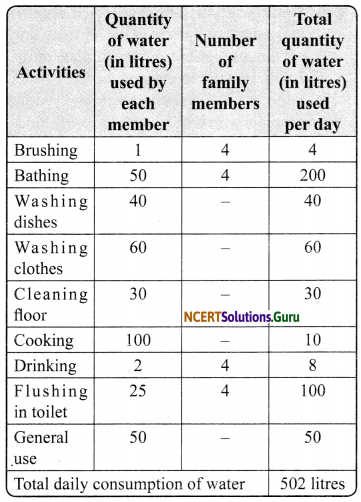
Conclusion: A family of four requires about 502 litres of water per day.
Sources of Water: Ponds, wells, streams, lakes and rivers are the different sources of drinking water. Drinking water is called as potable water. Oceans and seas supply water to other water bodies through water cycle.
States of Water: Water exists in three different states.
i. Water can occur in the solid state. Solid state can be represented by ice, snow or hail.
ii. Water can occur in the liquid state. Liquid state of water can be represented by river, rain or sea.
iii. Water can occur in the gaseous state. Gaseous state of water can be represented by water vapour.
Three states of water are inter-convertible
i. Solid form of water can be converted into liquid form by heating. This is called melting.
ii. Liquid form of water can be converted into gaseous form by heating. This is called vapourisation or evaporation.

iii. Gaseous form can be converted into liquid form by cooling and the process is called condensation.
iv. Liquid form can be converted into solid form by freezing.
Water cycle: The cyclic movement of water from the atmosphere to the Earth and back to the atmosphere through various processes is called as water cycle. Different steps of water cycle include evaporation, transpiration, condensation, precipitation and surface run-off.
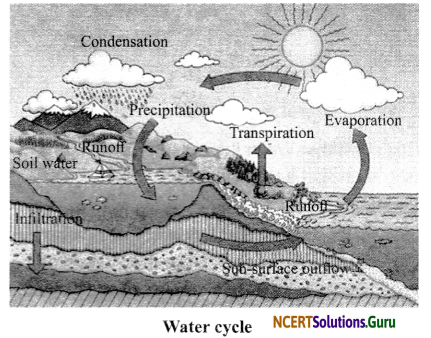
i. Evaporation: The water present on the surface of oceans evaporates by the sun’s heat. This process of conversion of water from liquid state to vapour state is called evaporation. Evaporation also takes place from wet clothes, fields, ponds, lakes and rivers.
![]()
Activity 2
Objective: To show that evaporation of water occurs in sunshine as well as in shade but it is faster in sunshine.
Materials required: Two similar plates and water.
Procedure:
- Take two similar plates.
- Place one of the plates in sunlight and keep the other under shade.
- Now, pour equal amount of water in each of the plates. You can use a cap of a bottle to measure water.
- Make sure that water does not spill over.
- Observe the two plates after every 15 minutes.
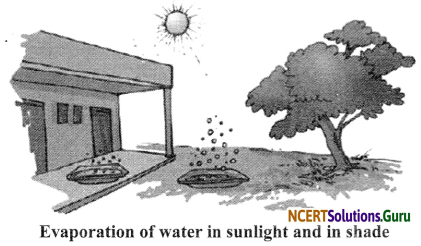
Observations: Water kept in sunlight evaporates faster than that kept in shade.
Conclusion: In sunlight, evaporation takes place faster because sunlight produces a higher temperature. In shade, evaporation takes place slower because of lower temperature in shade. Evaporation takes place continuously from all the open surfaces of water at all temperatures.
ii. Transpiration: Plants take in water from the soil to prepare their own food and also for other life processes. They release excess water into air through leaves in the form of water vapour by the process of transpiration.
iii. Condensation: The evaporated water is carried away by warm air. As the warm air moves higher from the surface of the Earth, it starts to cool down. This water vapour condenses to form tiny water droplets which float in air to form clouds or fog.
iv. Precipitation: When droplets of water present in clouds unite to form large sized drops of water, being heavy, they begin to fall. This falling of water drops from clouds is called precipitation. Precipitation may occur in the form of:
- Rain: If water droplets fall in form of liquid on the surface of the earth, it is called rain.
- Hail or snow: Precipitation may be in the form of frozen or solid form. If the size of frozen water drops is large, the precipitation is called as hail. If precipitation is in the form of light flakes, it is called snow.
- Dew: Water droplets, especially during winter nights, formed by water vapour present in the air, are called as dew.
Activity 3
Objective: To study how are clouds formed.
Materials Required: Glass and ice cubes.
Procedure:
- Take a glass half filled with water.
- Wipe the glass from the outside with a clean piece of cloth.
- Add some ice into the water. Wait for one or two minutes.
- Observe the changes that take place on the outer surface of the glass.

Drops of water appear on outer surface of the glass containing water with ice
Observations: The puff of air around the glass becomes hazy/cloudy. This is the cloud formed.
Conclusion: The cold surface of the glass containing ice water cools the air around it, and the water vapour of the air condenses on the surface of the glass.
v. Surface run-off: Some amount of rainwater is absorbed by the soil and settles down as groundwater. Most of the rainwater flows down the hills and mountains to collect into rivers, lakes or streams. Rain also washes away the topmost layer of the soil into water bodies.
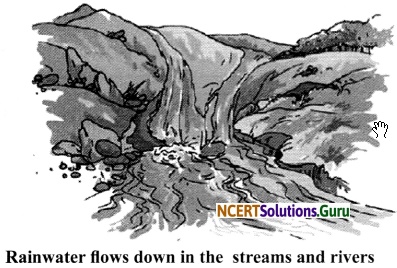
Importance of water cycle in nature
- Water cycle makes fresh water available in the form of rains.
- Water cycle keeps the amount of water on the earth’s surface constant. This is because the water removed from the earth during evaporation is put back to earth during rain and snowfall.
- Water cycle plays an important role in regulating weather.
Groundwater: The water that seeps into the ground and gets accumulated there is known as groundwater. Groundwater is the source of water in wells and lakes. Groundwater is withdrawn through hand pumps and tube wells.
Flood: Floods are caused by rise in the water level in ponds and lakes due to heavy rainfall. The excess rain water flows on to the land causing floods. Floods make the soil water-logged. Floods affect normal life by disturbing everything which comes in its way. Floods wash out the living beings such as plants, fish, other animals, etc. Floods cause heavy loss to human life. Floods cause uprooting of trees. They wash away the crops. They result in shortage of food supply.
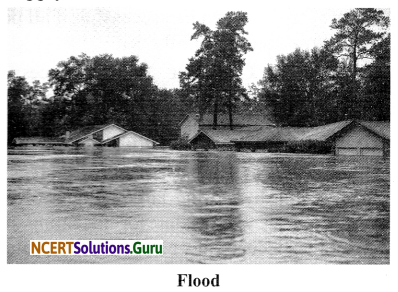
Droughts: Droughts are the conditions which involve abnormally long period of insufficient or no rainfall. Droughts are caused due to lack of rains. Drought condition results in drying up of wells, lakes, ponds and thereby creating water scarcity. Droughts result in the evaporation of water from the soil leaving the soil dry and patchy.
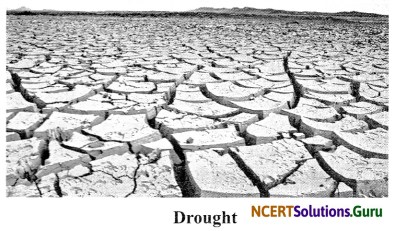
Effects of droughts
- Droughts result in mass death of plants and animals due to dehydration.
- It affects agriculture and lessen food production.
- It results in the death of animals and birds which provide us animal products like milk, meat and eggs. This scarcity of food results in the famine.
- Droughts result in forest fires caused by enormous amount of heat from scorching sun.
Water Conservation: Water is an essential natural resource. There exists no life without water. Water is so precious that it has to be conserved. Avoiding water wastage is also a kind of water conservation. Conservation programmes can be successful, if all people follow them faithfully.
How to Conserve Water: Excess rainwater running in the rivers is stored in huge and special structure called as dams. Dams are huge structures built on rivers to hold back excess water. Dams prevent areas from flooding by storing large amount of water. Dams provide water for irrigating fields, domestic use and also drinking water for some areas.
Drinking water should not be wasted to water the plants. Water bodies should not be polluted in order to get pure water. Water should not be wasted during irrigation of fields. Modem methods like spraying, sprinkling or drip irrigation should be used. Water should be used judiciously to avoid wastage. Destruction of trees should be controlled to increase the rainfall.
Rainwater harvesting: Rainwater harvesting includes collection and storing of rainwater from the roofs of houses and huge constructions. This is also called as rooftop rainwater harvesting. Constant use of freshwater from the ground results in water scarcity. Rainwater harvesting increases the level of underground water.
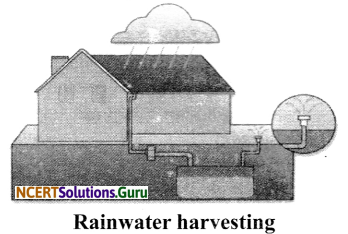
Technique involved in rainwater harvesting:
- Rainwater is collected at the rooftop.
- It is allowed to flow into pipes.
- It is filtered through wire mesh.
- It is allowed to pour into an underground tank setup to store rainwater. These tanks contain layers of sand, gravel, charcoal that will filter the dirt and other impurities from rainwater. This water seeps back into the ground slowly to increase the level of groundwater table.
- Second technique of rain water harvesting is to allow rainwater to go into the ground directly from the roadside drains.
Class 6 Science Chapter 14 Water Additional Important Questions and Answers
Very Short Answer Type Questions
Question 1.
Name two processes which are responsible for the formation of clouds.
Answer:
Evaporation and transpiration.
Question 2.
What happens to plants when they are not watered?
Answer:
If plants are not watered, they would wither. The seeds would not germinate and plants would not grow well.
![]()
Question 3.
Explain what you mean by evaporation.
Answer:
The process of changing water (liquid form) into water vapour (gaseous form) is called evaporation.
Question 4.
What happens to the potted trees when they are over watered? Why?
Answer:
Water logging takes place and the plant may die as roots are unable to take oxygen from the soil.
Question 5.
What would have been the consequence if the water was not recycled in nature by the water cycle?
Answer:
There would be no water available for use. Most of the natural phenomenon would be affected.
Question 6.
Why we rarely notice water vapour from a bucket full of water?
Answer:
We rarely notice water vapour from a bucket full of water because evaporation of water is a very slow process.
Question 7.
Why does a mist of tiny water droplets form when we breathe out on a window in winter?
Answer:
When our warm breath touches a cold window, it condenses and forms a mist of tiny water droplets.
Question 8.
In which forms does water exist on the earth?
Answer:
Water exists on the earth in all the three physical forms: ice (solid), water (liquid) and water vapour (gas).
Question 9.
How is snow or hail formed?
Answer:
When water droplets freeze in the air and begin to fall, it is called hail or snow.
Question 10.
What is precipitation?
Answer:
When water drops come together in the air and become heavy, they begin to fall. This falling of water drops is called precipitation.
![]()
Question 11.
What is the importance of convertibility of water from one state to another state?
Answer:
The easy convertibility of water from one state to another state makes its availability in all parts of the earth and throughout the year.
Short Answer Type Questions
Question 1.
What are the two main functions of water for living organisms?
Answer:
The two main functions of water for living organisms are:
- Water is very essential for the growth of plants, germination of seeds and in photosynthesis process.
- Water is also very essential for the transportation of goods and people.
Question 2.
Why is sea water not used for domestic use?
Answer:
Sea and ocean water contains huge amounts of different types of salts. Because of the presence of these salts, the ocean water is salty and cannot be used for any domestic purpose such as drinking, washing and for irrigation purposes. So, only water from lakes, rivers, ponds and rainwater harvesting are used for domestic purposes.
Question 3.
Why does the water which is spilt on the floor disappear after a period of time?
Answer:
Due to the process of evaporation, the water spilt on the floor is converted into water vapour. So it disappears after a period of time.
Question 4.
How does heavy rain affect us?
Answer:
Heavy rains may cause:
- rise of water level in reservoirs, rivers, pond, lakes, etc.,
- water logging in household areas,
- floods causing drastic damage to crops, property and animals.
![]()
Question 5.
How does the failure of rainfall affect people on the earth?
Answer:
The failure of rainfall can cause the following:
- The soil in that region becomes dry and may lead to drought.
- Water level in rivers, lakes, dams, etc., may fall below the minimum level, ponds and canals may even dry up. This results in people of that region having no access to water for even their basic needs.
- The ground water level will also fall.
Question 6.
There are 4 containers A, B, C and D with the same quantity of water in each of them. Answer the following questions based on these figures.
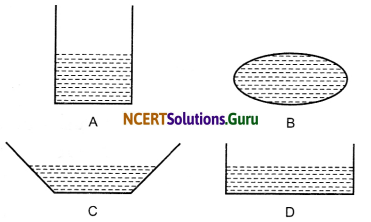
a. Identify in which container does the water evaporates faster than the rest?
b. Identify in which container the water evaporates at the slowest rate. Justify your answer.
Answer:
a. C – More the exposed surface area, more will be the rate of evaporation,
b. B – Since it is closed, evaporation will not take place.
Question 7.
Why do we see more fog in areas where there are a lot of trees during winter season?
Answer:
Due to the presence of a lot of trees, air at that region will have more water vapour than compared to cities or other regions. These water vapours tend to condense on smoke or dust particles which leads to the formation of thick fog.
Question 8.
What is the difference between fog and clouds?
Answer:
Clouds can form at many different altitudes. They can be as high as 12 miles above sea level or as low as the ground. Fog is a kind of cloud that touches the ground. Fog forms when the air near the ground cools enough to turn its water vapour into liquid water or ice.
![]()
Question 9.
What happens when there is a lot of rainfall?
Answer:
When it rains excessively, water gets collected here and there, causing disruption of normal life. The water levels of rivers, lakes and ponds rise. When it exceeds a certain maximum level, the water reservoirs cause floods. Crops, fields, villages and low-lying areas get submerged underwater. During floods, many animals living in water get trapped on land and die when the flood water recedes. Heavy rains also kill the animals living in soil because such animals do not get air to breathe when all the soil gets covered with floodwater.
Long Answer Type Questions
Question 1.
What ¡s meant by rainwater harvesting? Explain the different methods involved in rainwater harvesting.
Answer:
Rainwater harvesting is the process of collecting the rainwater and storing it in tanks, ponds, lakes, etc. In this process, rainwater in collected from the rooftops of houses or buildings with the help of pipes into a tank for storage purpose and can be used at a later point of time.
Methods involved in rainwater harvesting:
- Rooftop rainwater harvesting: In this structure, the rainwater from the rooftop is collected into a storage tank, employing pipes to collect and transfer.
- In another method, a huge pit is dug at close proximity to the house for collecting the rainwater. This pit is stuffed with different layers of coarse gravels, bricks and granite or sand pieces to filter rainwater.
Question 2.
What ¡s a water cycle? Describe the water cycle in nature. Also, draw a labelled sketch to show the water cycle in nature.
Answer:
Water keeps on circulating in nature.
Although we use water for different activities, the amount of water remains the same on the earth’s crust. This is maintained by the water cycle. The cyclic pattern in which water keeps moving from the oceans and seas to the sky as water vapour, from the sky to the land as rain or snow and from land to the oceans and seas is known as the water cycle.
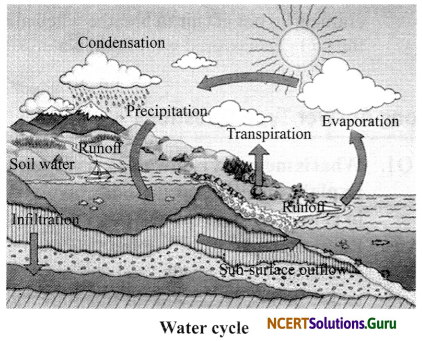
Question 3.
Write down the advantages and disadvantages of dams.
Answer:
Advantages:
- It stores water and provides water for irrigation.
- It leads to prevention of flooding because the water does not enter in the rivers in large quantities.
- It is used to generate electricity. The electricity generated by water in dams is called hydroelectricity.
Disadvantages:
- They can be constructed on limited sites.
- It affects aquatic life, plants and animals.
- The building of dams requires relocating population living in that area.
![]()
Question 4.
What are the problems faced by the people living in areas having drought conditions?
Answer:
Some of the problems faced by the people because of drought in an area are as follows:
- In drought conditions, the soil does not have sufficient moisture to grow crops well. Since the crop plants do not grow well, drought leads to severe shortage of food for the people in that region.
- In drought conditions, the vegetation such as grass and other fodder does not grow well and leads to shortage of fodder for the domestic animals like cows and buffaloes.
- Due to shortage of food and fodder, many people living in drought affected areas even migrate to other places along with their domestic animals in search of food and fodder. Some people and domestic animals may even die of starvation.
Question 5.
Explain the formation of (a) fog and (b) dew.
Answer:
a. Formation of fog: During winter, sometimes, condensation of water vapours starts near the surface of earth. These clouds of condensed vapour do not become water drops and do not rain. In fact these appear near the earth’s surface as fog.
b. Formation of dew: During winter nights, when air becomes very cool, the vapours present near earth’s surface condense and water droplets are formed. These appear as dew. This dew could be observed on railings, leaves and flowers in the winter mornings.
Picture-Based Questions
Question 1.
a. Identify the following states of water.
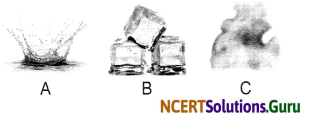
b. By which process can B be converted to A?
c. By which process can C be converted to A?
Answer:
a. A – Liquid water; B – Solid ice; C – Water vapour.
b. Melting
c. Condensation.
![]()
Question 2.
a. Name the process shown below.
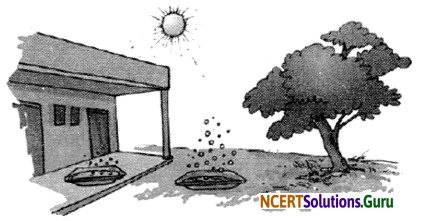
b. What does the above image depict?
Answer:
a. Evaporation
b. Evaporation takes place faster in sunlight than in shade.